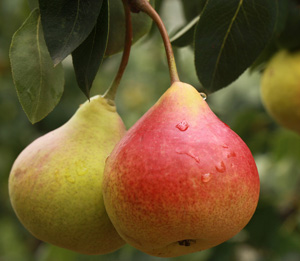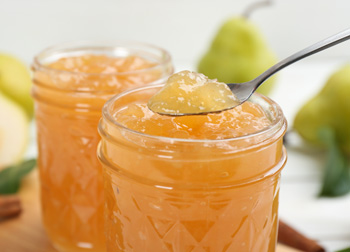Pears - A Fall Favorite
How to enjoy those fall favorites - Pears!
 Nashville, Ark. – Nothing welcomes the end of summer and the beginning of fall like
a pear! Fresh, juicy pears are in season from early fall through the beginning of
winter. So, there is plenty of time to enjoy this versatile fruit.
Nashville, Ark. – Nothing welcomes the end of summer and the beginning of fall like
a pear! Fresh, juicy pears are in season from early fall through the beginning of
winter. So, there is plenty of time to enjoy this versatile fruit.
How do I pick the best pear?
Choosing the best pear is simple. Just pick one up and feel it. It should feel hard. Pears are hand-picked unripe commercially to prevent fruit-destroying bruising when they are shipped to the store.
In fact, pears actually ripen better on your kitchen counter than they do on the tree. When they stay on the tree, they tend to develop a grainy texture.
How should I store pears?
Once picked, pears should remain on the counter. Not in the refrigerator to ripen. Place them in a bowl on the counter to ripen. Check them often for ripeness.
You can tell they are ripe when the flesh gives a little when gently pressed at the stem end. Once they are ready to eat, they may be stored in the refrigerator for 3 to 5 days. When deciding how best to eat them, well, it all depends on the variety of pear. And there are several varieties to choose from.
How to choose the perfect type of pear.
Anjou pears come in red and green. They have a sweet, mild flavor which makes them an excellent choice for eating raw as you would an apple. Leave them whole or slice them for a great snack. Anjou pears are also a great choice for using fresh in a salad. Just cube it and toss in a bed of greens. Use a light vinaigrette or balsamic vinegar dressing to compliment the pear.
Bartletts come in red and green. They are the only pears than can be picked when they change colors. They will change from green to yellow or an apple-like red. You do not need to press the stem area for ripeness, just watch for the color change. Juicy Bartletts are great raw and are also great for canning or baking. Bartlett pears do tend to fall apart when you cook them. They are perfect for making pear butter.
Boscs are pretty brown pears with elongated necks. They are very juicy and sweet. You can check for ripeness at the neck area by pressing near the stem for softness. You can also check for ripeness by looking at the skin near the stem. If it is wrinkled, it is ripe and ready to eat. Boscs are crisp when eaten raw, and they hold their shape when poaching, baking or for use in cooking.
Concorde pears have beautiful long, tapered necks. They are juicy, smooth, and do not brown as much as other pears when they are cut. Concorde pears are great raw or cooked. Choose Concorde pears for ripeness using the neck test. The red or russet color that is familiar with them is a sign of sun exposure, not ripeness.
When purchasing pears, only purchase a few at a time. They do not have a long shelf life. If you are fortunate enough to have a pear tree at your house and you need to use them in a hurry, be creative and use your culinary skills. Toss them in salads, bake them for a fancy dessert, eat them raw as a snack, or can them for use later.
However, you like to eat pears, take time to enjoy fresh ones this fall. No matter what fruit you are eating, it is best when eaten at the peak of their season.
For more information on eating or cooking with fruits, contact the Howard County Extension Office at 870-845-7517 or your local county Extension office. The Howard County office is located on the second floor of the courthouse.
Recipe of the Week: Pear Butter and Pear Preserves
 Do you have more pears than you know what to do with? Why not make some pear butter.
It is easy to make and can be used just like you would apple butter.
Do you have more pears than you know what to do with? Why not make some pear butter.
It is easy to make and can be used just like you would apple butter.
If you want to try something a little more challenging, make pear preserves. Both recipes are from the book, “So Easy to Preserve” a collection of tried-and-true recipes that are USDA approved. If you would like a copy of the book, contact our office or visit the website So Easy to Preserve.
Pear Butter
-
2 quarts pear pulp (about 20 medium, fully ripe pears)
-
4 cups sugar
-
1 teaspoon grated orange rind
-
½ cup orange juice
-
½ teaspoon ground nutmeg
-
To prepare the pulp – Quarter and core pears. Cook until soft, adding only enough water to prevent sticking. Press through a sieve or food mill. Measure pulp.
-
Add remaining ingredients; cook until thick, about 15 minutes. As mixture thickens, stir frequently to prevent sticking.
-
Sterilize canning jars. Pour hot butter into hot jars, leaving ¼-inch headspace.
-
Wipe jar rims and adjust lids.
-
Process 5 minutes in a boiling water bath.
Yield: about 4 half-pint jars
Pear Preserves
-
1 ½ cups sugar
-
2 ½ cups water
-
6 medium cored, pared, hard, ripe pears, cut in halves or quarters (about 2 pounds)
-
1 ½ cups sugar
-
1 thinly sliced lemon
-
Combine 1 ½ cups sugar with the 2 ½ cups water; cook rapidly for 2 minutes.
-
Add pears and boil gently for 15 minutes.
-
Add remaining sugar and lemon stirring until sugar dissolves.
-
Cook rapidly until fruit is clear, about 25 minutes.
-
Cover and let stand 12 to 24 hours in refrigerator.
-
Sterilize canning jars.
-
Heat fruit and syrup to boiling.
-
Pack fruit into hot jars, leaving ¼-inch headspace.
-
Wipe jar rims and adjust lids. Process 5 minutes in a boiling water bath.
Yield: about 5 half-pint jars
By Jean Ince
County Extension Agent - Staff Chair
The Cooperative Extension Service
U of A System Division of Agriculture
Media Contact: Jean Ince
County Extension Agent - Staff Chair
U of A Division of Agriculture
Cooperative Extension Service
421 N. Main St, Nashville AR 71852
(870) 845-7517
jince@uada.edu